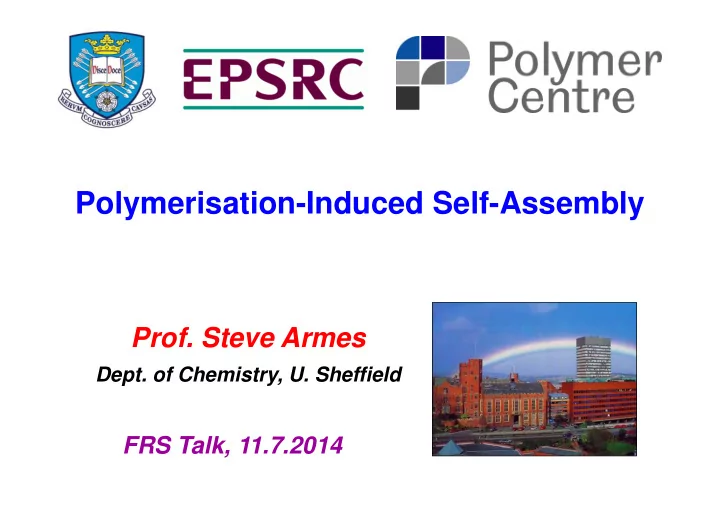

Polymerisation-Induced Self-Assembly Prof. Steve Armes Dept. of Chemistry, U. Sheffield FRS Talk, 11.7.2014
Polymers are Long-Chain Molecules = repeat unit Polymers (plastics) are ubiquitous in the modern world
Polymers are extremely racist + Pairs of red + blue polymers do not mix: Instead, macrophase -separated blends are formed on the micron length scale What happens if red and blue polymer chains are attached to each other? AB diblock copolymer Get microphase separation on 10-50 nm length scale! 3 � m Phase separation constrained by covalent bond between red and blue chains
How to make block copolymer nanoparticles Y. T. Li and S. P. Armes, Angewandte Chem ., 2010, 49 , 4042 Grow a water-insoluble polymer from one end of a water-soluble polymer in water X = 30 65 O O + O O X = 100 HO HO PGMA 65 – PHPMA X HO M M M M H H H H P P P P A A A A PGMA 65 macroCTA water-miscible X = 300 HPMA water-soluble PGMA 65 (but PHPMA is water-insoluble) Efficient aqueous formulation: > 99 % conversion within 2 h at 70 o C
1 H NMR & TEM Studies: PGMA 47 -PHPMA 200 77.5 min = 68 %, DP 131 A. Blanazs et al., JACS , 2011, 133 , 16581 Scale bars: 200 nm 84 mins = 75 %, DP 150 87 mins = 78 % DP 156 75 min = 62 %, DP 123 90 mins = 82 %, DP 164 225 mins = 100 % DP 200 65 min = 46 %, DP 92
Predictive Phase Diagrams Post-mortem TEM analysis of diblock copolymer morphology at > 99 % conversion Spheres Worms Vesicles 78 x Increasing PHPMA DP and copolymer concentration PGMA 78 -PHPMA x Phase diagrams serve as a ‘road map’ Enable reproducible synthesis of pure copolymer morphologies (s, w or v) Vary relative block volume fractions for rational design of particle size & shape S = spheres, W = worms, V = vesicles A. Blanazs, A. J. Ryan, S. P. Armes, Macromolecules 2012, 45 , 5099
Effect of Particle Morphology on Flow Properties = Entangled ‘worms’ hence higher viscosity? Anisotropic worms produce free-standing gels
Thermo-responsive Copolymer Worm Gels A. Blanazs, A. J. Ryan, S. P. Armes et al., JACS , 2012, 134 , 9741 An 8.0 w/v % aqueous solution of PGMA 54 PHPMA 140 Cool Heat < 5 o C 20 o C This sol-gel thermal transition is fully reversible
What Causes Reversible Copolymer (De)gelation? A. Blanazs, A. J. Ryan, S. P. Armes et al., JACS , 2012, 134 , 9741 TEM studies of a PGMA 54 -PHPMA 140 diblock copolymer: Cool Heat Initial copolymer Copolymer ‘spheres’ worms at 21 o C are formed at 4 o C Degelation due to reversible worm-to-sphere transition!
Cell Biology Applications for Biocompatible Worm Gels With Dr. I. Canton and Prof. H. Moore, manuscript in preparation Optical image of stem cell colonies within a PGMA-PHPMA worm gel Pluripotent stem cells receive no mechanical cues from worm gels Ki-67 and statin bio-assays: worm gel induces stem cell stasis? Stem cells remain undifferentiated within worm gels for 14 days Sufficient time to ship human stem cells anywhere in the world? Stem cells readily isolated from worm gel via cold centrifugation
ABC Triblock Copolymer Syntheses via RAFT Seeded Emulsion Polymerisation P. Chambon, A. Blanazs, G. Battaglia, S. P. Armes Macromolecules , 2012, 45 , 5081 PHPMA-PBzMA mixed vesicle BzMA membrane ~ 95 % BzMA conversion in 70 o C 2 h at 70 o C; M w /M n < 1.50 PGMA-PHPMA vesicles PGMA-PHPMA-PBzMA vesicles G 58 -H 360 G 58 -H 360 -B 200 G 58 -H 360 -B 300 G 58 -H 360 -B 400 Get micro-phase separation between PHPMA & PBzMA chains within membrane
PISA: a versatile generic platform technology Long-term storage of mammalian cells (GE Healthcare) Nanoparticle lubricants (Lubrizol) Improved thickeners (Scott Bader) Anti-reflective coatings for plastic substrates (DSM) Next-generation gas-permeable contact lenses (GEO) Microencapsulation applications (P & G) Bespoke nanoparticles for CaCO 3 occlusion (EPSRC) New efficient Pickering emulsifiers (ERC)
Conclusions Spherical block copolymer nanoparticles prepared in water Block copolymer worms obtained over a narrow copolymer composition range Worms form soft free-standing aqueous gels Block copolymer worm gels are thermo-responsive Do worm gels have biomedical applications for long-term storage of stem cells?
Acknowledgements: “Art is I, Science is We” (Claude Bernard) ~ 50 PhD students and ~ 50 post-docs at U. Sussex and U. Sheffield Prof. Brian Vincent (PhD supervisor at U. Bristol) Dr. Matt Aldissi (Post-doc supervisor at LANL, New Mexico) Prof. Norman Billingham (long-term collaborator at U. Sussex) Prof. Tony Ryan OBE (long-term collaborator at U. Sheffield) £££: EPSRC, ERC, The Royal Society and many industrial companies Thank you for your attention
Recommend
More recommend